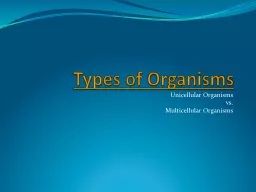

Unicellular Organisms vs Multicellular Organisms Background information What does micro mean What is a microscope What is an organism What does multi mean What is a cell Micro ID: 586851
Download Presentation The PPT/PDF document "Types of Organisms" is the property of its rightful owner. Permission is granted to download and print the materials on this web site for personal, non-commercial use only, and to display it on your personal computer provided you do not modify the materials and that you retain all copyright notices contained in the materials. By downloading content from our website, you accept the terms of this agreement.
Slide1
Types of Organisms
Unicellular Organisms
vs.
Multicellular OrganismsSlide2
Background information
What does “micro” mean?
What is a microscope?
What is an organism?
What does “multi” mean?
What is a cell?Slide3
Micro
Something very small.
When referring to an organism, it can NOT be seen without a microscope.Slide4
Microscope
What is a microscope?
is an
instrument
used to see
objects that are too small for
the naked
eye.
What is an instrument?
In science, it refers to laboratory
equipment or tools in a laboratory used by
Scientists. This includes instruments
such as a microscope
.Slide5
What is an Organism?
Definition:
Organism – anything that can live on its ownSlide6
Cells
What is a cell?
Cells are the basic building blocks of all living things.
For example, the
human body is composed of trillions of cells.
They
provide structure for the body, take in nutrients from food, convert those nutrients into energy, and carry out specialized functions.Slide7
Unicellular
OrganismsSlide8
Unicellular Organisms
Definition:
Unicellular organism – an organism made of only one cell
Uni
– means “one”.
Information:
These organism are very small and need to be seen with a microscope.
These organisms CANNOT be seen with the naked eye.Slide9
Unicellular:Common Names
Micro
scopic Organisms
Micro
organisms
Really small
living thingsSlide10
Examples of Unicellular Organisms
Amoeba
Bacteria
Protozoa
Unicellular algae
Unicellular fungi
Unicellular yeasts
Paramecium (picture)Slide11
Images of Unicellular OrganismsSlide12
More Images of Unicellular OrganismsSlide13
Multicellular
OrganismsSlide14
Multicellular Organisms
Definition:
Multicellular organism – an organism made of two or more cells
Information:
These organisms
are able
to be seen with the naked eye.
These organisms need all parts of itself to survive
.Slide15
Common Names
Many – celled organisms
Eukaryotic organisms
Mammals
Birds
Reptile
FishMany others…
If you can SEE an organism, it is multicellularSlide16
Examples of Multicellular Organisms
Humans
Cats
Dogs
Insects
Birds
Flowers
Mold
TreesSlide17
Images of Multicellular OrganismsSlide18
More Images of Multicellular OrganismsSlide19
Compare/Contrast
Unicellular Organisms – (one celled) organisms are good models for membrane transport, because they need to perform MANY functions with one cell, rather than many types of cells.
Multicellular
organisms- organisms
that consist of more than one cell, in contrast to single-celled organisms. To form a multicellular organism, these cells need to identify and attach to the other cells.Slide20
Review
What type of organism is a hamster?
Multicellular
Unicellular
What is a unicellular organism?
a.
An organism with many cells.
b.
An organism that requires a microscope to view it.